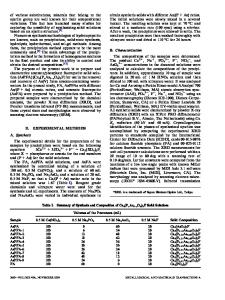Synthesis of Phosphate Phosphors
Phosphors exhibit a number of interesting size and surface dependent optical properties, which have stimulated an exponential development of material science and technology in the past era because the luminance properties, as well as morphological and str
- PDF / 657,809 Bytes
- 17 Pages / 439.37 x 666.142 pts Page_size
- 88 Downloads / 374 Views
Synthesis of Phosphate Phosphors
Phosphors exhibit a number of interesting size and surface dependent optical properties, which have stimulated an exponential development of material science and technology in the past era because the luminance properties, as well as morphological and structural characteristics, strongly depend on phosphors synthesis conditions. There is no rigid definition of what constitutes a suitable synthesis. The major criterion by which syntheses are judged is the potential value to the scientific community. An ideal synthesis is one that presents a new or revised experimental procedure applicable to a variety of related compounds, at least one of which is critically important in current research. However, syntheses of individual compounds that are of interest or importance are also acceptable. Syntheses of compounds that are readily available commercially at reasonable prices are not acceptable.
3.1 Sample Preparation Methods and Calculations Looking at the chemical formula of most of the inorganic phosphors one may feel that the synthesis of the luminescent materials should be straightforward as the host materials are well-known [1]. However, in practice, the synthesis of the phosphors with desired characteristics can be quite tricky. The difficulties arise as one has to consider several aspects such as the incorporation of the activators at the desired sites, elimination of the unwanted impurities, specific grain size, and morphology suitable for the application, cost of production, batch homogeneity, and reproducibility, and so on. Many methods of preparation are listed in Table 3.1. All these methods are not used in the present study. Hence, methods which were used for the materials synthesized and described in this book are summarized in this chapter with full details later at the experimental synthesis part added at the beginning of each phosphor material reported later in this book.
K. N. Shinde et al., Phosphate Phosphors for Solid-State Lighting, Springer Series in Materials Science 174, DOI: 10.1007/978-3-642-34312-4_3, © Springer-Verlag Berlin Heidelberg 2012
61
62
3 Synthesis of Phosphate Phosphors
Table 3.1 A list of various methods for preparing the samples Sr. No.
Technique
Method
1 2
Wet chemical Solid state
3
Novel synthesis
Co-precipitation, recrystallization Melting Solid-state diffusion Molten salt Solvothermal method Sol–gel Hydrolytic sol–gel Nonhydrolytic sol–gel Pechini and citrate gel methods Polymer pyrolysis Spray pyrolysis and sonochemical Cryochemical synthesis (including freeze drying) Solid-state metathesis
3.2 Wet Chemical Method Wet chemical synthesis is one of the simplest syntheses techniques currently available (also called the one-step synthesis) [2, 3]. Hence, the molecular motions and the chemical reactions may proceed very swiftly in the liquid state. Reactions of the type acid + base → salt often yield precipitate of the desired compound. Wet chemical synthesis is an ideal technique used for producing fine, chemically homogeneous, and
Data Loading...











